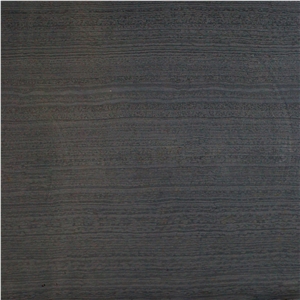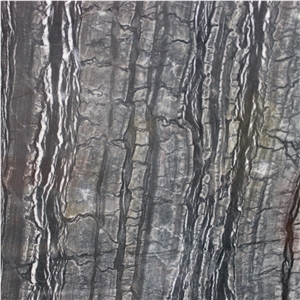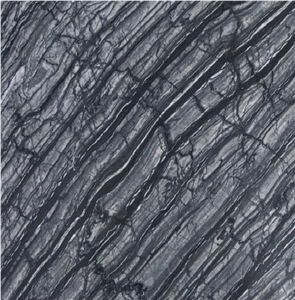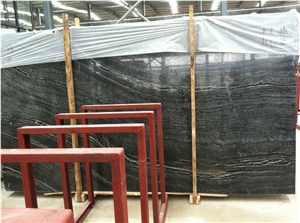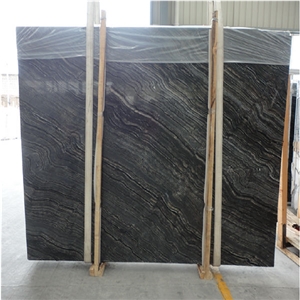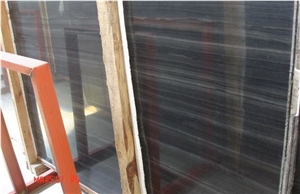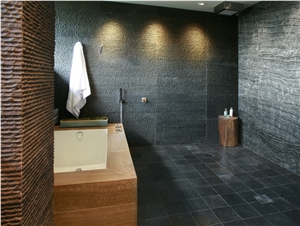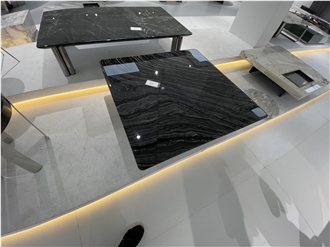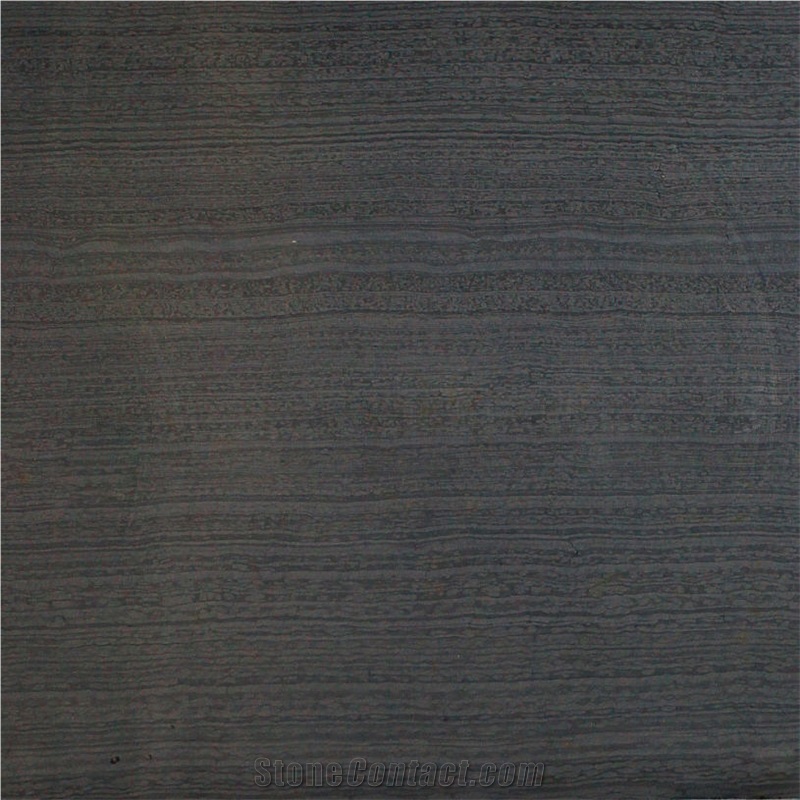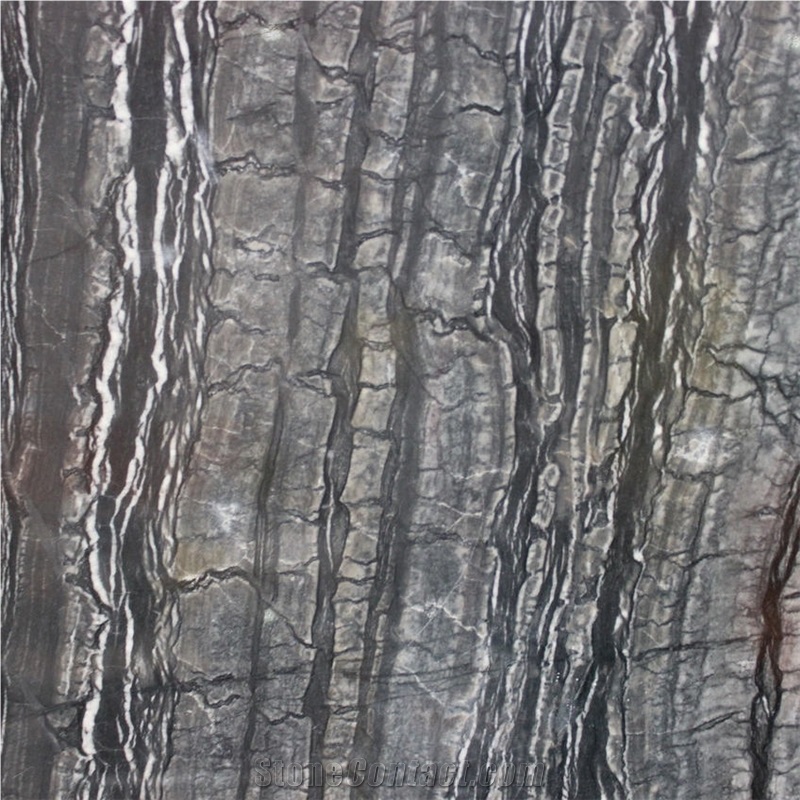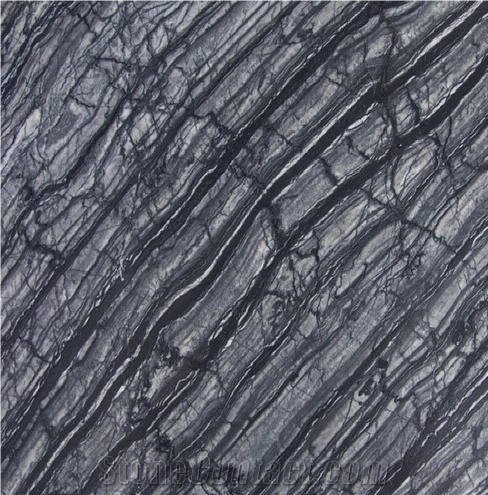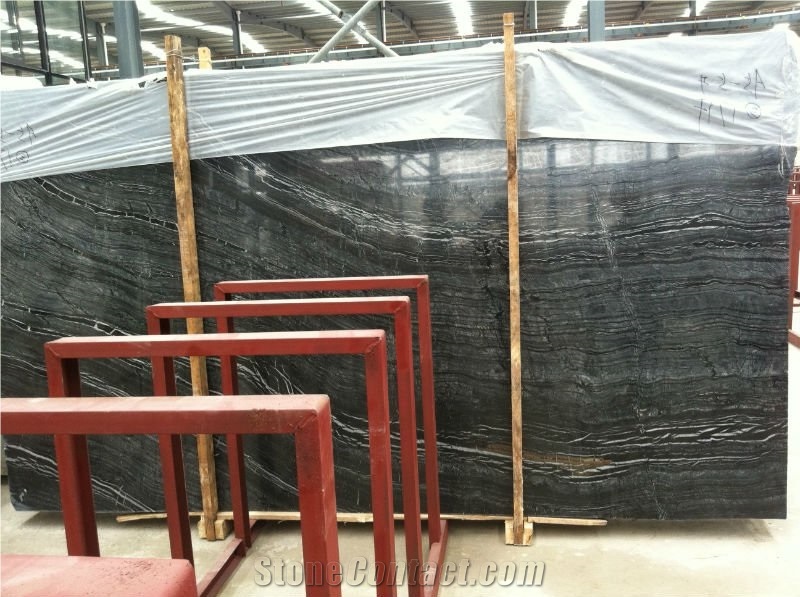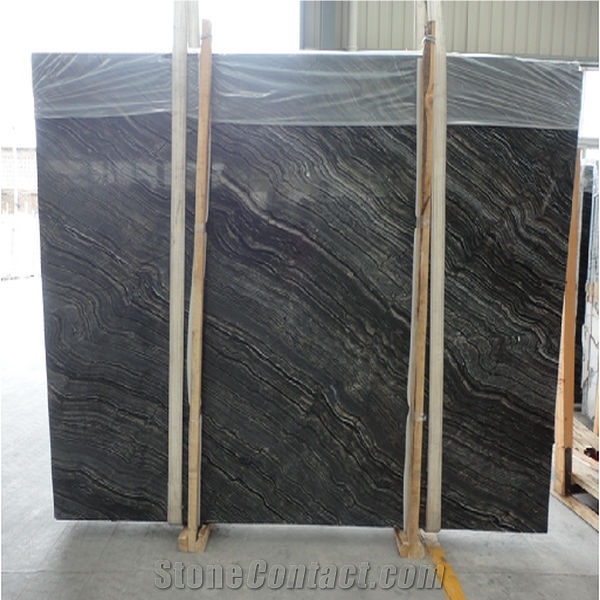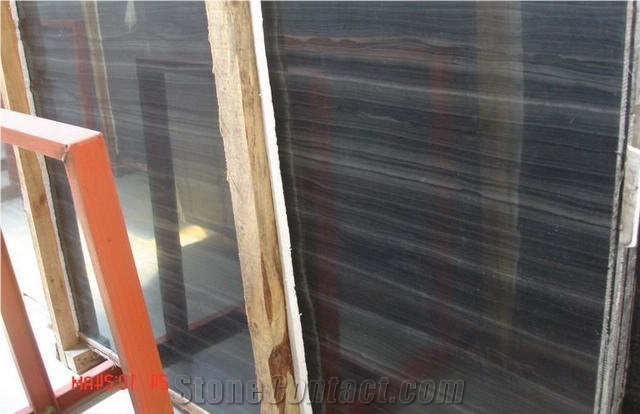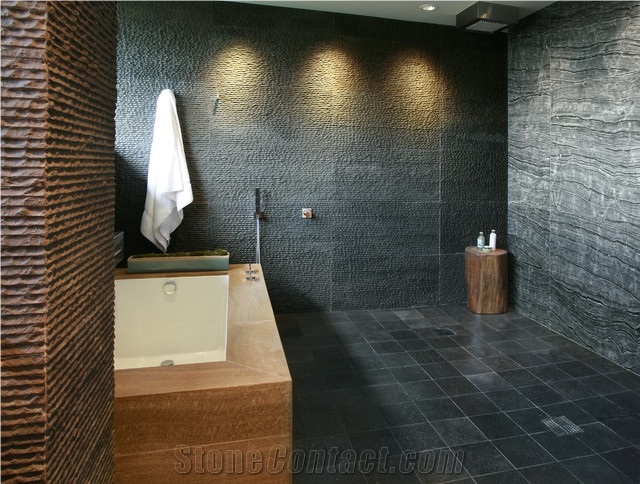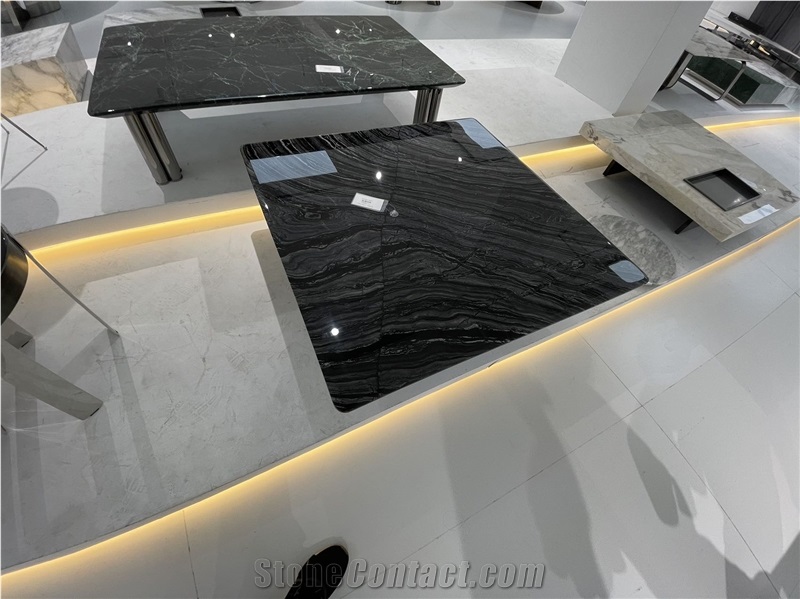Black Wood Vein Marble
 China
(Guizhou)
China
(Guizhou)
Black Wood Vein Marble is a type of black wooden vein patterned marble quarried in China. It is a captivating natural stone known for its dark black background with distinctive vein patterns that resemble the grain of wood, adding a unique and artistic touch to any space.
Appearance:Black Wood Vein Marble features a deep black color as its base, which provides a bold and sophisticated look. The most striking feature of this marble is the prominent vein patterns that run through the stone. These vein patterns, resembling the grain of wood, can vary in color from white to light beige or gold, creating a stunning contrast against the dark background.
Physical Characteristics:As with all marble, Black Wood Vein Marble is a metamorphic rock formed from limestone that has undergone significant heat and pressure over time. It exhibits the characteristic crystalline structure and relative softness typical of marble, allowing for intricate carving and detailing.
Applications:Black Wood Vein Marble's unique appearance makes it a popular choice for a variety of interior design and architectural applications, such as:
--Flooring: The deep black color and distinct wood-like veining patterns make it an excellent option for creating striking flooring designs.
--Wall Cladding: Black Wood Vein Marble is commonly used as wall coverings, adding a touch of elegance and drama to interior spaces.
--Countertops: It is a favored choice for kitchen countertops and bathroom vanity tops, providing a luxurious and eye-catching surface.
--Decorative Elements: The stone's captivating vein patterns make it ideal for crafting decorative items, sculptures, and custom furniture pieces.
Cultural Significance:China has a long history of marble production and export, and Black Wood Vein Marble is a testament to the country's rich geological resources and craftsmanship. This unique marble variety showcases the skill and creativity of Chinese artisans and has gained popularity both locally and internationally.
Maintenance:As with any marble, proper care and maintenance are essential to preserve the beauty of Black Wood Vein Marble. Regular sealing is recommended to protect the stone from staining and moisture penetration.
It's important to note that specific details about individual marble quarries, including "Black Wood Vein Marble," may vary. For the most accurate and up-to-date information about this marble variety, it is recommended to consult with local stone suppliers or quarries in China.

What is the standard size of Black Wood Vein Marble reception table?

Can I use vinegar on Black Wood Vein Marble sink?

Are Black Wood Vein Marble sinks hard to clean?

How does Black Wood Vein Marble countertop react to heat?

Can China's Black Wood Vein Marble be used in a living room?

How thick is China's Black Wood Vein Marble slabs?

What happens if Black Wood Vein Marble gets too hot?

Is Black Wood Vein Marble good for swimming pool?

What grade is China's Black Wood Vein Marble?

What is the coefficient of friction of Chiseled China's Black Wood Vein Marble tiles?

Can China's Black Wood Vein Marble be used in wall coverings?

Can China's Black Wood Vein Marble be used exterior applications in very sunny climates?

Can heat cause Black Wood Vein Marble fireplace to crack?

Does chlorine affect Black Wood Vein Marble?

Is China's Black Wood Vein Marble an expensive stone?

Can China's Black Wood Vein Marble be used indoors?

Is Black Wood Vein Marble or granite better for stairs?

How far should Black Wood Vein Marble reception desk be from wall?

Are there color variations of China's Black Wood Vein Marble?

What is sandblasted finish Black Wood Vein Marble?

Can I use Black Wood Vein Marble for a kitchen sink?

What is the minimum depth of a Black Wood Vein Marble reception desk?

How do you antique Black Wood Vein Marble?

Are polished Black Wood Vein Marble steps slippery?

Is Black Wood Vein Marble heat tolerant?

What is antique finish Black Wood Vein Marble?

Can Black Wood Vein Marble be given a flamed surface treatment?
-

 India
India
 3YRDiamond members are premium members on platform, providing members with comprehensive approach to promoting their products, increasing products exposure and investment return to maximize.
3YRDiamond members are premium members on platform, providing members with comprehensive approach to promoting their products, increasing products exposure and investment return to maximize.
 Verified Supplier is for prove company authenticity,including business license,trade license and effective office space,to enhance buyers' trust to suppliers and their products, reducing communication costs.
Verified Supplier is for prove company authenticity,including business license,trade license and effective office space,to enhance buyers' trust to suppliers and their products, reducing communication costs.
Contact Supplier
-

 China
China
 15YRDiamond members are premium members on platform, providing members with comprehensive approach to promoting their products, increasing products exposure and investment return to maximize.
15YRDiamond members are premium members on platform, providing members with comprehensive approach to promoting their products, increasing products exposure and investment return to maximize.
 Verified Supplier is for prove company authenticity,including business license,trade license and effective office space,to enhance buyers' trust to suppliers and their products, reducing communication costs.
Verified Supplier is for prove company authenticity,including business license,trade license and effective office space,to enhance buyers' trust to suppliers and their products, reducing communication costs.
Contact Supplier
-

Shenzhen Leeste Industry Co., Ltd
 China
China
 12YRDiamond members are premium members on platform, providing members with comprehensive approach to promoting their products, increasing products exposure and investment return to maximize.
12YRDiamond members are premium members on platform, providing members with comprehensive approach to promoting their products, increasing products exposure and investment return to maximize.
 Verified Supplier is for prove company authenticity,including business license,trade license and effective office space,to enhance buyers' trust to suppliers and their products, reducing communication costs.
Verified Supplier is for prove company authenticity,including business license,trade license and effective office space,to enhance buyers' trust to suppliers and their products, reducing communication costs.
Contact Supplier
-

 China
China
 12YRDiamond members are premium members on platform, providing members with comprehensive approach to promoting their products, increasing products exposure and investment return to maximize.
12YRDiamond members are premium members on platform, providing members with comprehensive approach to promoting their products, increasing products exposure and investment return to maximize.
 Verified Supplier is for prove company authenticity,including business license,trade license and effective office space,to enhance buyers' trust to suppliers and their products, reducing communication costs.
Verified Supplier is for prove company authenticity,including business license,trade license and effective office space,to enhance buyers' trust to suppliers and their products, reducing communication costs.
Contact Supplier
-

-

Shenzhen Leeste Industry Co., Ltd
 China
China
 12YRDiamond members are premium members on platform, providing members with comprehensive approach to promoting their products, increasing products exposure and investment return to maximize.
12YRDiamond members are premium members on platform, providing members with comprehensive approach to promoting their products, increasing products exposure and investment return to maximize.
 Verified Supplier is for prove company authenticity,including business license,trade license and effective office space,to enhance buyers' trust to suppliers and their products, reducing communication costs.
Verified Supplier is for prove company authenticity,including business license,trade license and effective office space,to enhance buyers' trust to suppliers and their products, reducing communication costs.
Contact Supplier
-

-

-

JIUJIANG QUNFENG STONE CO.,LIMITED
 China
China
 7YRDiamond members are premium members on platform, providing members with comprehensive approach to promoting their products, increasing products exposure and investment return to maximize.
7YRDiamond members are premium members on platform, providing members with comprehensive approach to promoting their products, increasing products exposure and investment return to maximize.
 Verified Supplier is for prove company authenticity,including business license,trade license and effective office space,to enhance buyers' trust to suppliers and their products, reducing communication costs.
Verified Supplier is for prove company authenticity,including business license,trade license and effective office space,to enhance buyers' trust to suppliers and their products, reducing communication costs.
Contact Supplier
-

 China
China
 16YRDiamond members are premium members on platform, providing members with comprehensive approach to promoting their products, increasing products exposure and investment return to maximize.
16YRDiamond members are premium members on platform, providing members with comprehensive approach to promoting their products, increasing products exposure and investment return to maximize.
 Verified Supplier is for prove company authenticity,including business license,trade license and effective office space,to enhance buyers' trust to suppliers and their products, reducing communication costs.
Verified Supplier is for prove company authenticity,including business license,trade license and effective office space,to enhance buyers' trust to suppliers and their products, reducing communication costs.
Contact Supplier
The request includes: 1. surface finished, size 2. quantity required






